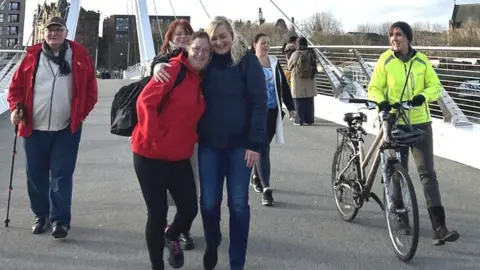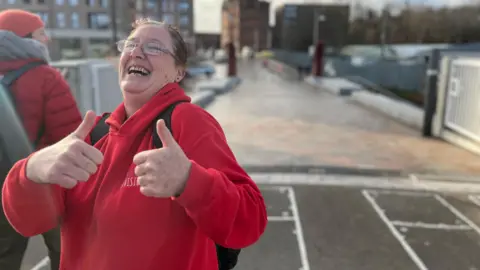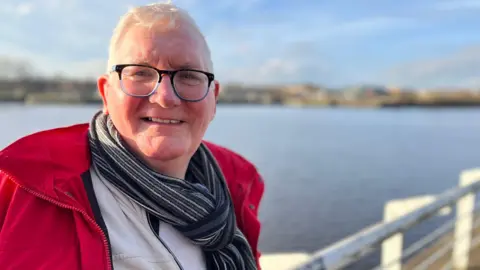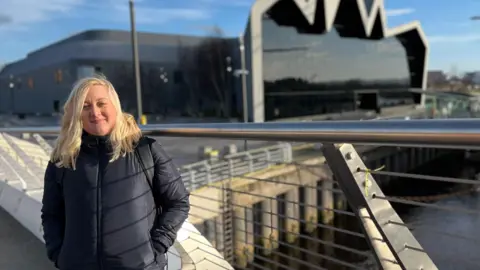Tour group walks community back to happiness
 BBC
BBCThey come from every walk of life, but it is the act of walking itself that brings them together.
In Glasgow's Govan area, a collection of people gather every Thursday morning for banter, exercise and friendship.
The recently-opened bridge connecting the communities of Partick and Govan either side of the River Clyde is opening new social and cultural connections for them.
"Meet Me in Govan" is a free, open-to-anyone project run by the social enterprise Invisible Cities which trains people who have been affected by homelessness to be tour guides.
Angela McTague is one of them. She has been a walk leader with Meet Me in Govan since it started in 2021. She's also a tour guide with Invisible Cities in Glasgow.
"Everybody from the city can come and do a wee walk and have a chat and a wee talk about certain buildings and places that we're going to visit," she said.
"We exchange stories and Govan's got a lot of history so it's good to let people know all the history.
"Govan was here before Glasgow."
The mental and physical health benefits of the role have been life-changing for Angie. She's overcome dyslexia, depression, and in 2018 she had a heart attack.
She said: "It took me a year to remember all the information because I've got dyslexia so it goes in alright but it doesn't come out alright.
"That's why I have a great laugh on some of my tours."
Through walking she's lost almost six stone (38kg) in weight.
"I was depressed for a long time and I wasn't well and I couldn't deal with things so I just withdrew into myself and I didn't deal with anything," she said.
"So it's helped to get my confidence up because if you told me in 2018 I'd be doing this, I'd have said 'no, I don't think so'.
"But I have, I've been doing it and I really enjoy it."

The walking route changes all the time, and includes activities like visiting with residents at local care homes, podcasting at a community radio station or making their own magazine.
Stephen is a support worker from Florence House care home in Govan.
He said the walks make a "huge difference" to those who take part.
It makes such a difference to residents, he said, to meet new people and also builds their confidence.
'I now know more than the Govanites'
The walks are educational too with rotational discussion themes including housing, work, culture, immigration, sports and wellbeing.
Pensioner John Karol from Corkerhill is one of the regulars.
He joked he knows more about Govan now than people that call themselves "Govanites".
He said: "It's great to speak to people. It's great to see interesting places and just basically it's great to get me out of the house."
"A lot of people aren't interested in history but I am. I've seen the Govan Stones that they reckon come from the Vikings. They're a bit of a mystery.
"And there's a tomb there for King Constantine of Scotland."

In the same way that the act of walking serves as a bridge uniting people from varied backgrounds: old and young, immigrants and born-and-bred Glaswegians, fit walkers and those with disabilities, a new bridge is rekindling community connections over the water.
The £29.5m Govan-Partick bridge opened in September, through the Scottish and UK governments' Glasgow City Region Deal, replicating the historic ferry link in operation for over 200 years until the 1960s.
Karyn MacDonald lived in Partick 30 years ago, and recently returned to the neighbourhood after living abroad.
As a member of Partick Community Council she sees the potential for a similar scheme there.
She said: "I think there are a lot of people who live here who don't know a lot of the historical facts about Partick and I think it would be great to let locals know more about the place that they live.
"Also if we can get a group up and running in Partick then it would be ideal to meet up with the Meet Me in Govan people and we can do things together, bringing both communities together - especially now we have the bridge."

More "Meet Me In" community walks could be starting up in locations where Invisible Cities already runs tours, including Edinburgh and Galashiels in the Borders.
Michaela Ditrichova, project manager at Invisible Cities said: "We really hope to expand this project to other parts of Glasgow and elsewhere in Scotland."
